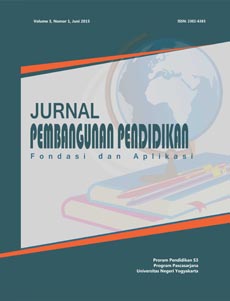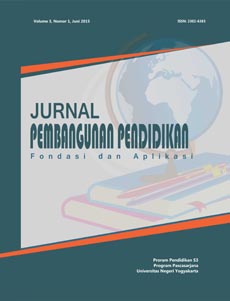Improving student learning outcomes through collaboration of the Student Teams Achievement Division (STAD) and Jigsaw learning models
DOI:
https://doi.org/10.21831/jppfa.v10i2.56231Keywords:
Collaboration, Jigsaw learning model, student learning outcomes, Student Teams Achievement Division (STAD) learning modelAbstract
References
Bartanen, B., Rogers, L. K., & Woo, D. S. (2021). Assistant Principal Mobility and Its Relationship With Principal Turnover. Educational Researcher, 50(6), 368–380. https://doi.org/10.3102/0013189X21993105
Creswell, J. W. (2014). A concise introduction to mixed methods research. SAGE publications. https://www.ptonline.com/articles/how-to-get-better-mfi-results
Elpisah, E., & Bin-Tahir, S. Z. (2019). Student team achievement division (Stad) model in increasing economic learning outcomes. International Journal of Scientific and Technology Research, 8(10), 3089–3092.
Endo, T., Chiba, G., van Rooijen, W. F. G., Yamanaka, M., & Pyeon, C. H. (2018). Experimental analysis and uncertainty quantification using random sampling technique for ADS experiments at KUCA. Journal of Nuclear Science and Technology, 55(4), 450–459. https://doi.org/10.1080/00223131.2017.1403387
Flores, R., Lillo, R., & Romo, J. (2018). Homogeneity test for functional data. Journal of Applied Statistics, 45(5), 868–883. https://doi.org/10.1080/02664763.2017.1319470
Jankowski, K. R. B., Flannelly, K. J., & Flannelly, L. T. (2018). The t -test: An Influential Inferential Tool in Chaplaincy and Other Healthcare Research. Journal of Health Care Chaplaincy, 24(1), 30–39. https://doi.org/10.1080/08854726.2017.1335050
Jobst, L. J., Auerswald, M., & Moshagen, M. (2022). The Effect of Latent and Error Non-Normality on Measures of Fit in Structural Equation Modeling. Educational and Psychological Measurement, 82(5), 911–937. https://doi.org/10.1177/00131644211046201
Kılıí§, S., Tan, M. N., & Mevsim, V. (2021). Validity and reliability of Turkish version of the craving experience questionnaire in the assessment of cigarette smoking. Journal of Substance Use, 26(5), 475–482. https://doi.org/10.1080/14659891.2020.1851403
Lee, A., & Griffin, C. C. (2021). Exploring online learning modules for teaching universal design for learning (UDL): preservice teachers' lesson plan development and implementation. Journal of Education for Teaching, 47(3), 411–425. https://doi.org/10.1080/02607476.2021.1884494
Li, J., & Xue, E. (2022). Meta-conceptualizing the high-quality education system: Insight from China. Educational Philosophy and Theory, 1–9. https://doi.org/10.1080/00131857.2022.2118577
Liu, C., & Jurich, D. (2023). Outlier Detection Using t-test in Rasch IRT Equating under NEAT Design. Applied Psychological Measurement, 47(1), 34–47. https://doi.org/10.1177/01466216221124045
Liu, Y., & Zheng, B. (2022). Comparability of difficulty levels of translation tasks in CET-6 parallel test forms: evidence from product and process-based data. The Interpreter and Translator Trainer, 16(4), 428–447. https://doi.org/10.1080/1750399X.2022.2036938
Mathews, H. M. (2021). Developing a Theory of Program Vision as Professional Socialization in Special Education Teacher Preparation. Teacher Education and Special Education: The Journal of the Teacher Education Division of the Council for Exceptional Children, 088840642110589. https://doi.org/10.1177/08884064211058901
O'Leary, N., Barber, A., & Keane, H. (2019). Physical education undergraduate students' perceptions of their learning using the jigsaw learning method. European Physical Education Review, 25(3), 713–730. https://doi.org/10.1177/1356336X18767302
Partin, R. D., Meldrum, R. C., Lehmann, P. S., Back, S., & Trucco, E. M. (2022). Low Self-Control and Cybercrime Victimization: An Examination of Indirect Effects Through Risky Online Behavior. Crime & Delinquency, 68(13–14), 2476–2502. https://doi.org/10.1177/00111287211061728
Psaradakis, Z., & Vávra, M. (2020). Normality tests for dependent data: large-sample and bootstrap approaches. Communications in Statistics - Simulation and Computation, 49(2), 283–304. https://doi.org/10.1080/03610918.2018.1485941
Rahimi, S., Ahmadian, M., Amerian, M., & Dowlatabadi, H. R. (2020). Comparing Accuracy and Durability Effects of Jigsaw Versus Input Flood Tasks on the Recognition of Regular Past Tense /-ed/. SAGE Open, 10(2), 215824402091950. https://doi.org/10.1177/2158244020919505
Sadowska, N., & Laffy, D. (2019). Measuring the impact of strategic design learning experience long after the classroom delivery. The Design Journal, 22(sup1), 1305–1315. https://doi.org/10.1080/14606925.2019.1594957
Sakthivel, V. P., Suman, M., & Sathya, P. D. (2020). Squirrel search algorithm for economic dispatch with valve-point effects and multiple fuels. Energy Sources, Part B: Economics, Planning, and Policy, 15(6), 351–382. https://doi.org/10.1080/15567249.2020.1803451
Shi, W., You, Y., Shao, P., & Wan, Y. (2014). Standard deviation of line objects in geographic information science. Annals of GIS, 20(1), 39–51. https://doi.org/10.1080/19475683.2013.862297
Sun, S., Li, Z., & Jiang, H. (2022). Homogeneity test and sample size of risk difference for stratified unilateral and bilateral data. Communications in Statistics - Simulation and Computation, 1–24. https://doi.org/10.1080/03610918.2022.2142240
Virkkula, E. (2022). Student teachers' views of competence goals in vocational teacher education. European Journal of Teacher Education, 45(2), 250–265. https://doi.org/10.1080/02619768.2020.1806229
West, R. M. (2021). Best practice in statistics: Use the Welch t -test when testing the difference between two groups. Annals of Clinical Biochemistry: International Journal of Laboratory Medicine, 58(4), 267–269. https://doi.org/10.1177/0004563221992088
Xiao, L., & Hau, K.-T. (2022). Performance of Coefficient Alpha and Its Alternatives: Effects of Different Types of Non-Normality. Educational and Psychological Measurement, 001316442210882. https://doi.org/10.1177/00131644221088240
Yuliani, N. (2019). The Role of Student Teams Achievement Divisions (STAD) in Improving Student's Learning Outcomes. Classroom Action Research Journal, 3(1), 8–15. https://doi.org/10.17977/um013v3i12019p008
Published
How to Cite
Issue
Section
Citation Check
License
The Authors submitting a manuscript do so on the understanding that if accepted for publication, copyright publishing of the article shall be assigned to Jurnal Pembangunan Pendidikan: Fondasi dan Aplikasi
 | Jurnal Pembangunan Pendidikan: Fondasi dan Aplikasi by https://journal.uny.ac.id/index.php/jppfa is licensed under a Creative Commons Attribution-ShareAlike 4.0 International License. |














